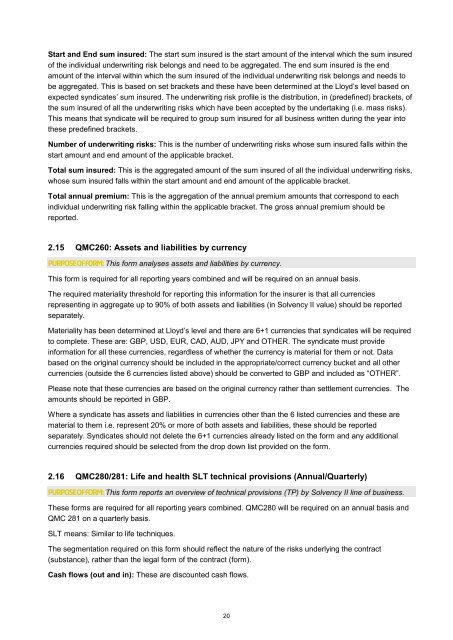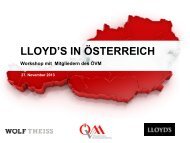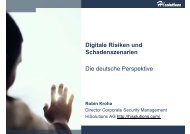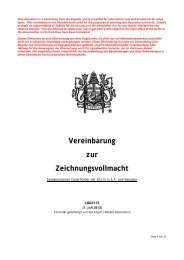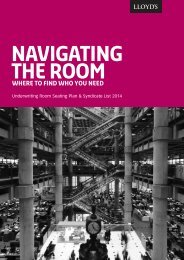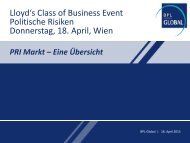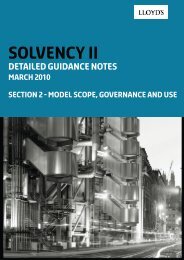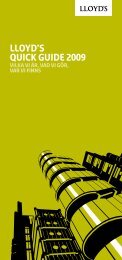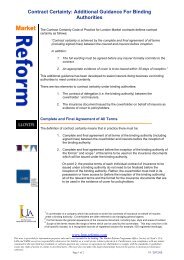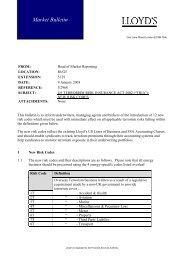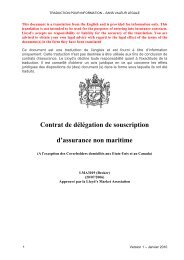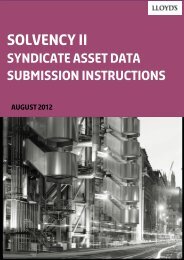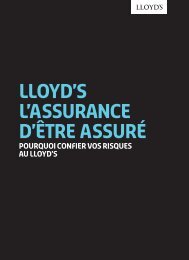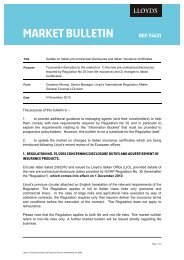Create successful ePaper yourself
Turn your PDF publications into a flip-book with our unique Google optimized e-Paper software.
Start and End sum insured: The start sum insured is the start amount of the interval which the sum insured<br />
of the individual underwriting risk belongs and need to be aggregated. The end sum insured is the end<br />
amount of the interval within which the sum insured of the individual underwriting risk belongs and needs to<br />
be aggregated. This is based on set brackets and these have been determined at the Lloyd’s level based on<br />
expected syndicates’ sum insured. The underwriting risk profile is the distribution, in (predefined) brackets, of<br />
the sum insured of all the underwriting risks which have been accepted by the undertaking (i.e. mass risks).<br />
This means that syndicate will be required to group sum insured for all business written during the year into<br />
these predefined brackets.<br />
Number of underwriting risks: This is the number of underwriting risks whose sum insured falls within the<br />
start amount and end amount of the applicable bracket.<br />
Total sum insured: This is the aggregated amount of the sum insured of all the individual underwriting risks,<br />
whose sum insured falls within the start amount and end amount of the applicable bracket.<br />
Total annual premium: This is the aggregation of the annual premium amounts that correspond to each<br />
individual underwriting risk falling within the applicable bracket. The gross annual premium should be<br />
reported.<br />
2.15 QMC260: Assets and liabilities by currency<br />
Purpose of form: This form analyses assets and liabilities by currency.<br />
This form is required for all reporting years combined and will be required on an annual basis.<br />
The required materiality threshold for reporting this information for the insurer is that all currencies<br />
representing in aggregate up to 90% of both assets and liabilities (in <strong>Solvency</strong> <strong>II</strong> value) should be reported<br />
separately.<br />
Materiality has been determined at Lloyd’s level and there are 6+1 currencies that syndicates will be required<br />
to complete. These are: GBP, USD, EUR, CAD, AUD, JPY and OTHER. The syndicate must provide<br />
information for all these currencies, regardless of whether the currency is material for them or not. Data<br />
based on the original currency should be included in the appropriate/correct currency bucket and all other<br />
currencies (outside the 6 currencies listed above) should be converted to GBP and included as “OTHER”.<br />
Please note that these currencies are based on the original currency rather than settlement currencies. The<br />
amounts should be reported in GBP.<br />
Where a syndicate has assets and liabilities in currencies other than the 6 listed currencies and these are<br />
material to them i.e. represent 20% or more of both assets and liabilities, these should be reported<br />
separately. Syndicates should not delete the 6+1 currencies already listed on the form and any additional<br />
currencies required should be selected from the drop down list provided on the form.<br />
2.16 QMC280/281: Life and health SLT technical provisions (Annual/Quarterly)<br />
Purpose of form: This form reports an overview of technical provisions (TP) by <strong>Solvency</strong> <strong>II</strong> line of business.<br />
These forms are required for all reporting years combined. QMC280 will be required on an annual basis and<br />
QMC 281 on a quarterly basis.<br />
SLT means: Similar to life techniques.<br />
The segmentation required on this form should reflect the nature of the risks underlying the contract<br />
(substance), rather than the legal form of the contract (form).<br />
Cash flows (out and in): These are discounted cash flows.<br />
20


